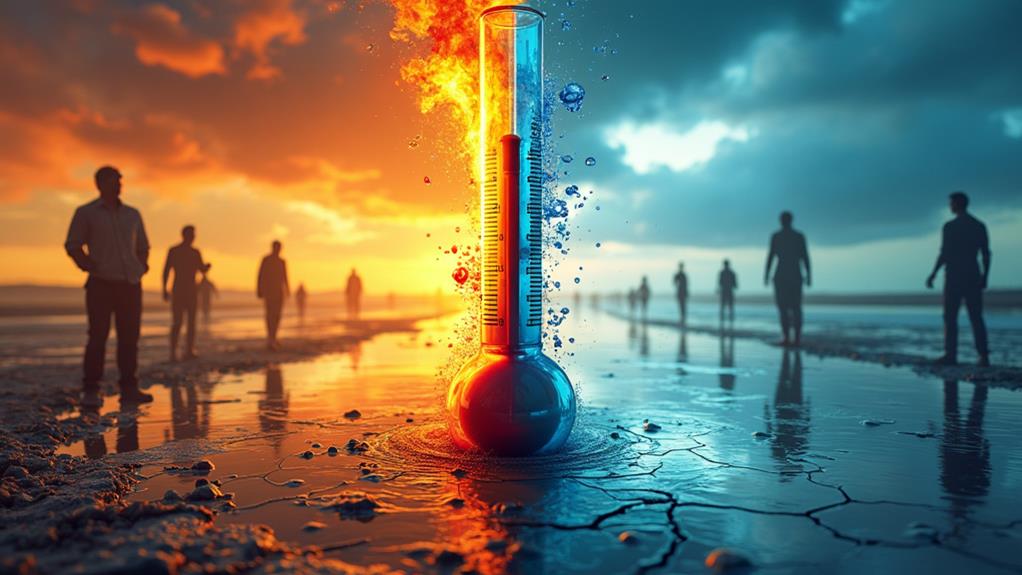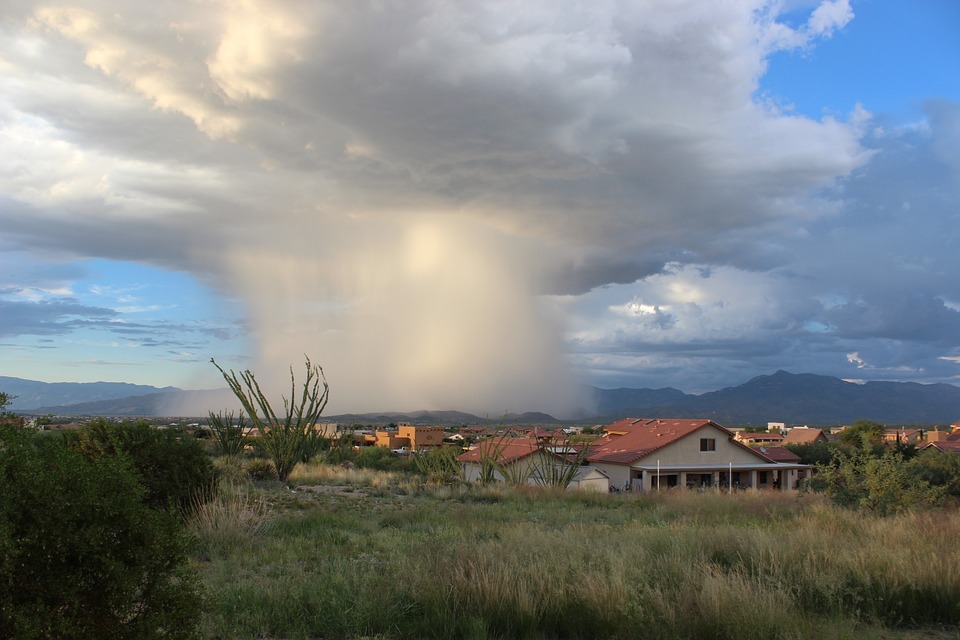What Are the Effects of Extreme Temperature Fluctuations?

Extreme temperature fluctuations can seriously affect your health, exacerbating respiratory and cardiovascular diseases and increasing risks of heat-related illnesses. Vulnerable groups such as children, the elderly, and low-income communities are particularly at risk. These weather shifts strain energy infrastructures, leading to power outages, and impact agriculture by reducing crop yields and food quality. Urban heat islands make matters worse, escalating health risks in crowded areas. The effects extend to increased mortality rates and the spread of diseases. To understand all the nuances and protective measures, there's much more you can uncover.
Key Takeaways
- Extreme temperature fluctuations increase the risk of heat-related illnesses and worsen chronic respiratory and cardiovascular conditions.
- Vulnerable populations, including children, older adults, and low-income communities, face heightened health risks during extreme temperature changes.
- Fluctuating temperatures strain energy infrastructure, leading to frequent blackouts, especially in urban areas with high energy demand.
- Extreme heat adversely affects agricultural productivity, reducing crop yields and livestock fertility, impacting food security and economic stability.
- High temperatures accelerate food spoilage in transit, increasing waste and driving up prices, disproportionately affecting low-income communities.
Health Impacts
Extreme temperature fluctuations pose significant health risks, particularly during intense heat events. You might experience heat-related illnesses like heat cramps, heat exhaustion, and heatstroke during these periods. It's essential to be aware of how extreme heat events impact your health.
For those with pre-existing health conditions, especially respiratory and cardiovascular diseases, the effects can be more severe. Chronic exposure to extreme heat can exacerbate these conditions, leading to a rise in hospital visits and even mortality rates during warmer months. The urban heat island effect compounds these risks, as densely populated areas with lots of manmade surfaces absorb and retain more heat, making it harder to escape the high temperatures.
You should also consider the impact of sudden temperature changes. These can trigger respiratory issues and worsen allergies, affecting your general well-being. Cold weather isn't any less dangerous; it's linked to a higher incidence of cardiovascular events, adding another layer of risk when temperatures drop suddenly.
Vulnerable Populations
Frequently, vulnerable populations bear the brunt of extreme temperature fluctuations. You might notice that children, older adults, and those with pre-existing health conditions face considerable health risks during these periods. Extreme weather events like heatwaves or cold snaps can lead to severe complications, including heat exhaustion, heatstroke, hypothermia, and exacerbation of chronic illnesses.
Low-income communities are particularly at risk because they often lack access to vital resources such as air conditioning or adequate heating. This lack of resources makes them more susceptible to the adverse effects of extreme heat and cold. Racial and ethnic minorities also face disproportionate health impacts due to systemic inequities and environmental disparities in their neighborhoods. These factors combine to increase their vulnerability to extreme weather events.
Outdoor workers, including construction workers and agricultural laborers, are also highly susceptible to extreme temperatures. The prolonged exposure can result in heat-related illnesses, greatly increasing their risk of heat exhaustion and heatstroke. Furthermore, the elderly are especially vulnerable, with studies showing a higher incidence of hospital visits and mortality rates among this demographic during extreme temperature fluctuations. Addressing these vulnerabilities is vital for mitigating the health risks posed by extreme weather events.
Climate Change and Death Rates

The escalating temperatures driven by climate change are leading to a troubling increase in death rates during warmer months. From April to September, you can expect to see more heat waves, which are directly linked to higher mortality rates. Data from 209 U.S. cities, using a 1990 baseline, shows a net increase in death rates as temperatures rise. While colder months might see a decrease in death rates, the general effect points to a concerning trend.
During extreme heat events, heat-related illnesses become more common, especially among vulnerable populations. This leads to a spike in hospital visits and, unfortunately, higher mortality rates. The rising temperatures also facilitate the spread of vector-borne diseases, adding another layer of health risk that pushes mortality rates even higher.
Long-term climate patterns and extreme weather events are also contributing to an increase in respiratory and cardiovascular diseases. These health issues further raise death rates, making the impact of climate change on public health quite alarming. As temperatures continue to rise, the combined effects of heat waves, disease spread, and chronic conditions will likely lead to a significant increase in mortality rates.
Public Health Improvements
Amid the growing concerns over extreme temperature fluctuations, improving public health infrastructure is more important than ever. You can help improve urban health resilience by supporting environmental modifications like increasing green spaces and installing cool roofs. These measures not only mitigate the effects of extreme temperature conditions but also enhance air quality.
Expanding access to air conditioning and establishing cooling centers is vital, especially for vulnerable populations during extreme heat. You should advocate for policies that make these resources more accessible. On the flip side, guaranteeing access to central heating is essential to protect individuals from the adverse effects of extreme cold, such as hypothermia and cardiovascular stress.
Developing thorough surveillance systems for climate-related health issues is another key step. By monitoring and preparing for these health impacts, communities can better respond to the challenges posed by climate change. Community preparedness plans are crucial for effective action during temperature extremes.
Investing in public health infrastructure involves collaboration between governmental and non-governmental organizations. By working together, you can adapt to and mitigate the health consequences of climate change and extreme temperature fluctuations. Taking these proactive steps will guarantee a healthier and more resilient community.
Research Needs

Building on the significance of enhancing public health infrastructure, a strong focus on research needs will pave the path for effective interventions against extreme temperature fluctuations. You need to prioritize studies that explore how heat and changing weather patterns impact health, especially when considering other climate stressors. This research is fundamental for crafting public health strategies that can better protect communities.
You should also look into the effectiveness of early warning systems and community preparedness plans. By understanding how well these systems work, you can improve them to mitigate the risks associated with extreme temperature fluctuations. It's similarly important to investigate social determinants of vulnerability. Identifying which populations are most at risk enables you to tailor interventions that provide the most benefit.
Longitudinal studies are significant for examining the long-term health effects of chronic exposure to temperature extremes, such as the development of respiratory and cardiovascular diseases. Finally, don't overlook the need for funding groundbreaking solutions and technologies aimed at reducing greenhouse gases. This financial support is crucial for advancing research that addresses both the causes and health impacts of extreme temperature fluctuations. By focusing on these areas, you'll be better equipped to tackle the challenges posed by our changing climate.
Energy Infrastructure
Extreme temperature fluctuations place immense stress on energy infrastructure, leading to frequent blackouts that disproportionately impact vulnerable populations. During extreme heat events, the demand for electricity skyrockets as everyone cranks up their air conditioners. This surge often overwhelms the electric grid, causing widespread power outages. Unfortunately, these blackouts hit low-income communities and individuals reliant on medical equipment the hardest, posing significant health risks.
To understand the full impact of these temperature swings on energy infrastructure, consider the following:
- Increased Blackouts: The frequency of blackouts rises annually due to the higher demand for cooling during heat waves.
- Urban Heat Island Effect: Densely populated areas absorb more heat, exacerbating energy demand and straining local resources.
- Grid System Stress: Electric grid systems face significant stress during extreme heat events, making blackouts more likely.
- Infrastructure Upgrades Needed: There's a critical need to upgrade energy infrastructure to include improved cooling systems and handle increased demands.
Agricultural Effects

Just as extreme temperature fluctuations strain our energy infrastructure, they also wreak havoc on agriculture. When you think about agricultural productivity, extreme heat is a major culprit in reducing crop yields. Wheat, for example, suffers immensely under heat stress, and you'll notice not just smaller harvests but also a decline in nutritional value. This directly impacts food quality and availability, posing significant challenges for food security.
Livestock isn't spared either. Extreme temperatures cause decreased fertility rates and make animals more susceptible to diseases. For anyone relying on animal products, this can mean less meat, milk, and eggs on the market, further straining food supplies.
Transportation and storage of food are also vulnerable. When it's hot, food spoils faster, and you're likely to see more waste in the supply chain. This inefficiency drives up food prices, making it tougher for everyone, especially low-income communities, to afford basic necessities.
Frequently Asked Questions
Can You Get Sick From Drastic Temperature Changes?
You can get sick from drastic temperature changes. Your immune response might weaken, making you more susceptible to illnesses. If you have temperature sensitivity, your body's struggle to adapt can trigger respiratory issues or exacerbate allergies. Cold exposure can increase the risk of cardiovascular events and stress your body's ability to maintain ideal blood circulation. Generally, drastic temperature changes can seriously impact your health and wellbeing.
What Are the Effects of Severe Temperature?
Ever wondered how severe temperature affects you? Temperature stress disrupts your body's thermal regulation, leading to health issues like heatstroke or hypothermia. Vulnerable groups, such as the elderly, struggle more with climate adaptation. Urban areas feel it worse due to the heat island effect, increasing mortality rates during heatwaves. Sudden changes can also trigger respiratory problems and allergies, making it harder for your body to cope.
How Do Extreme Weather Events Affect Humans?
Extreme weather events affect you in different ways. They can strain your mental health, leading to anxiety and stress. Social behavior changes as communities face disruptions and increased tension. Economically, the impact is profound, causing job losses and reduced productivity, especially in outdoor sectors. You might also see a rise in healthcare costs due to weather-related illnesses. In general, these events create significant challenges in daily life.
How Does Extreme Heat Affect Your Body?
When the sun's a bit too friendly, your body feels it. You might experience heat exhaustion and dehydration risks, leading to serious health issues. Your body's natural cooling system struggles, making heat acclimatization harder. Extreme heat can mess with your heart and lungs, increase hospital visits, and aggravate existing conditions. Staying hydrated and cool is essential to keep everything running smoothly and avoid those nasty heat-related problems.




